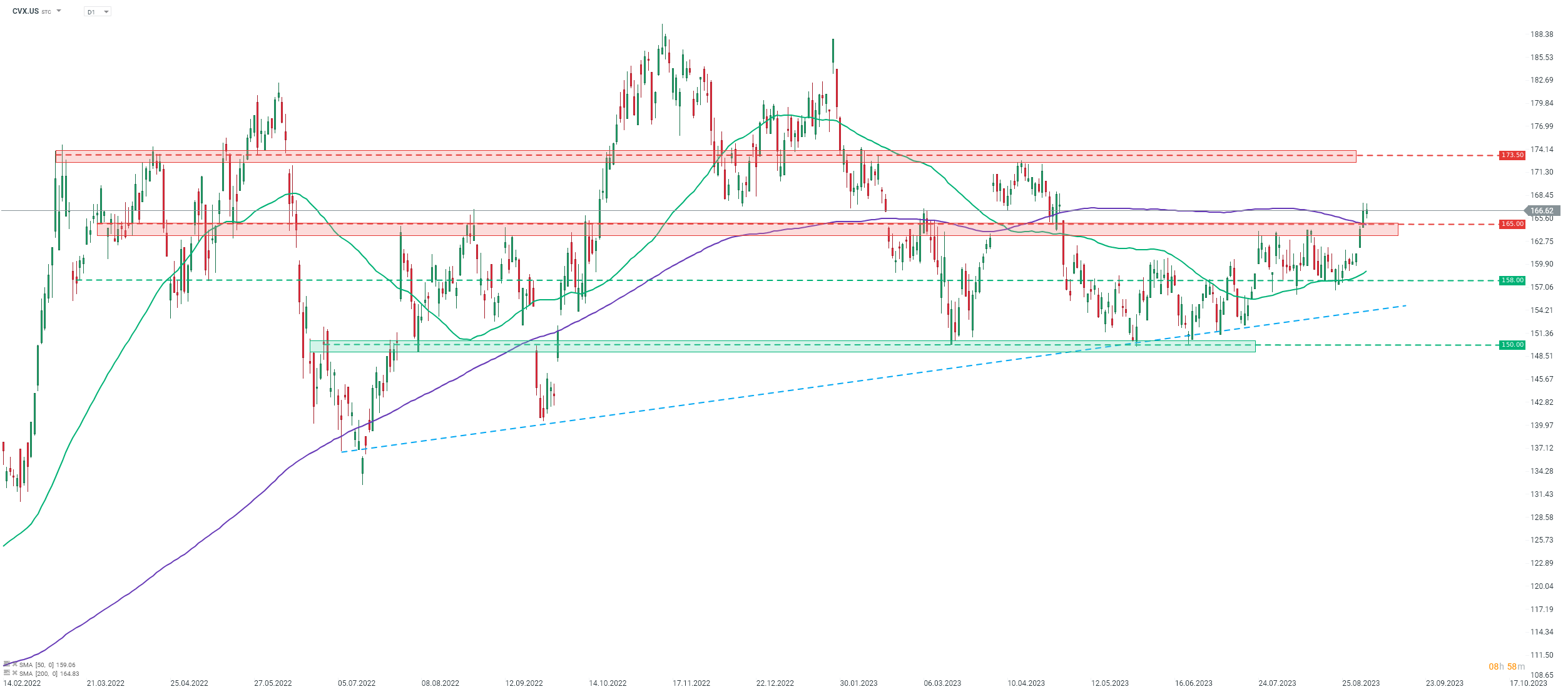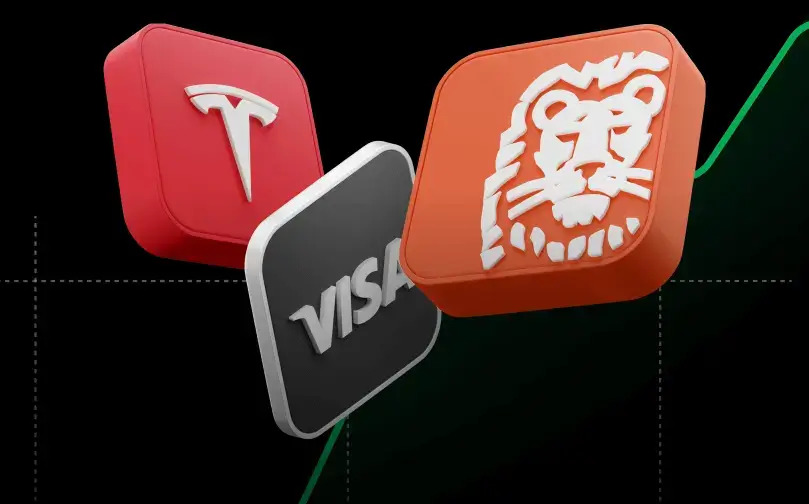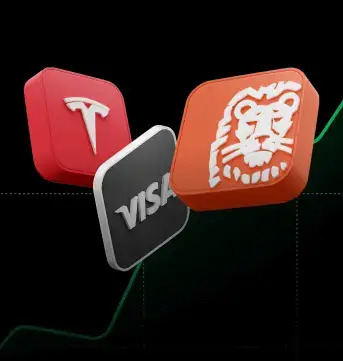- Chevron trades at 4-month high
- Saudi Arabia and Russia extend supply cuts
- AI craze disconnected Chevron from broad market indices
- Chevron trades at higher multiples than peers
Chevron (CVX.US) as well as other major US oil companies are trading higher this week in spite of declines on the broad market. This is, of course, driven by this week's supply announcements from OPEC+ countries - Saudi Arabia and Russia. However, on a year-to-date basis Chevron has been underperforming compared to broad stock market, oil and other oil supermajors so far this year. Let's take a closer look at the company!
OPEC+ extends cuts
An output cut extension announcement from Saudi Arabia was expected this week but it still caught markets off guard. This is because the Kingdom decided to extend the 1 million barrel cut through the end of the year, not just through October as market expected. Russia made a similar announcement minutes later, saying that it will extend the 300k barrel export cut through the end of 2023 as well. This has triggered a jump in oil prices with Brent (OIL) jumping above $90 per barrel for the first time since November 2022 and WTI (OIL.WTI) moving above $87 per barrel.
Chevron and oil prices
What should not come as a surprise is the fact that Chevron's stock is to a huge extent reliant on oil prices. Taking a look at the chart below, we can see how Chevron's stock performed compared to oil price and S&P 500 index this year. However, if we consider 5-year correlation coefficients, the story looks different. Correlation coefficient of daily returns of Chevron and Brent over the past 5-years was around 0.50 while that of Chevron and S&P 500 was around 0.62. However, this discrepancy between 5-year correlation and year-to-date correlation can be easily explained - AI craze! S&P 500 has enjoyed strong gains this year, especially at the beginning of the year, as it was being propped up by a rally in AI-related tech shares.
Chevron's share price moves have been more closely resembling oil price moves so far this year. However, it should be said Chevron has been underperforming oil since the end of Q2 2023. Source: Bloomberg Finance LP, XTB
Chevron underperformed peers this year
In spite of S&P 500 trading over 16% year-to-date higher and Brent gaining 5% so far this year, Chevron stock has been struggling. Shares are trading 7% below 2022 close and are clearly underperforming other oil supermajors, like for example ExxonMobil (+3.8%), Shell (+7.7%), BP (+8.6%) or TotalEnergies (+2.1%). This can be to some extent explained with company-specific factors like employee strikes at Chevron LNG plants in Australia. However, the main reason looks to be Chevron's relatively weaker fundamentals. ExxonMobil is the best peer for comparison as both stocks are US-domiciled and this comparison shows that ExxonMobil has been achieving higher rates of return on assets and common equity than Chevron.
Chevron has been underperforming other oil supermajors so far this year. Source: Bloomberg Finance LP, XTB Research
Multiples: Chevron vs peers
Chevron's share price underperformance this year, however, did not fully offset weaker fundamentals. A look at a multiple comparison of Chevron and its peers in the table below, we can see that Chevron looks quite 'expensive' compared to other oil supermajors. Of course, as we have said before ExxonMobil is the best peer to compare as country-specific factors, like accounting or tax issues, are absent.
Chevron is trading at a higher multiple than ExxonMobil in almost every case, spare for Price-to-Book-Value. Multiples for Shell, BP and TotalEnergies are even lower but this can be reasoned with a generally weaker performance of European stock markets compared to Wall Street. A point to note is that valuing Chevron using mean multiples would result in a below-market valuation in every case, with EV/Sales showing the lowest valuation (48% below Chevron's current market price). The highest valuation - from mean P/BV multiple - is still around 18.5% below current market price of Chevron.
Multiple comparison of Chevron and other oil supermajors. Source: Bloomberg Finance LP, XTB
Dividend valuation model
Chevron is a company with a long history of dividend payments. Company has been paying out dividends for over 3 decades now. A dividend paying stock can be valued using Gordon Growth Model, which relies on assumption for dividend growth and required rate of return. Using 5-year average dividend growth of 5.60% and a 5-year mean cost of equity of 9.44% as required rate of return, the model arrives at a $156.40 price tag for Chevron's shares. This is 6.1% below current market price.
However, as is the case with many valuation models, the Gordon Growth Model is highly sensitive to assumptions, especially as we have to make an assumption on a constant future dividend growth rate. A sensitivity matrix can be found below that shows how model valuation changes as we change dividend growth or required rate of return forecast in steps of 0.05 percentage points.
Sensitivity matrix for Chevron's Gordon Growth Model. Source: XTB Research
A look at the chart
Taking a look at Chevron (CVX.US) chart at D1 interval, we can see that the pair bounced off the $158.00 swing area, that served as the lower limit of the trading range, at the end of August and has managed to climbed above the upper limit of the range in the $165.00 area this week, thanks to a jump in oil prices. A point to note is that the $165.00 resistance zone was also marked with the 200-session moving average (purple line). Stock finished yesterday's trading near 4-month highs, defying a market-wide pullback triggered by US services ISM beat. The next resistance zone to watch can be found ranging around $173.50 mark.

Source: xStation5
Daily summary: Sentiments on Wall Street stall at the end of the week🗽US Dollar gains
AbbVie near 1-month low after earnings report 📉
Wall Street optimism tempers amid falling odds of December Fed rate cut
DE40: Decline of sentiment in Europe


